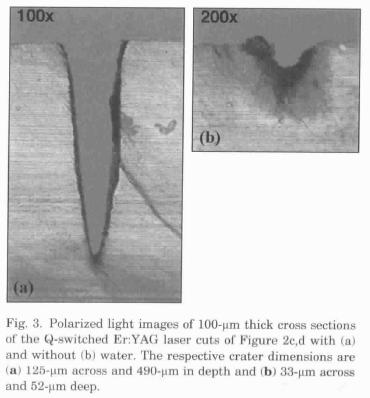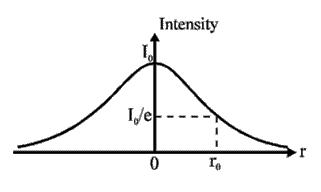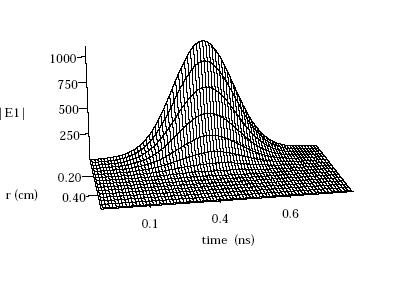Forums › Laser Resources › Laser Physics Related Literature › Hydrokinetics Article
- This topic is empty.
-
AuthorPosts
-
AnonymousGuestRay,
Since all clinical techniques being taught today (including the use of ‘contact tips’) suggest that movement and water is necessary to keep the abaltion going and not being stalled out, can you show me any SEM’s that show melting and cracking when the above protocol is followed?
If the above protocol is carefully followed and no cracks or melting takes place, how would rehydration take place? Why would it be necessary if new, as yet unlazed and unheated (vaporized) areas are being lased? Also, couldn’t the water cause the ablation byproducts to not be as good a heat absorber(by keeping them cooler) and thus the energy would penetrate deeper reaching new areas that have not yet been vaporized?
Can you show me anything that shows a difference (using the above protocol) and a water film vs. spray?
Why do you assume that the area of dehydration is the same as hyperthermia? Can’t tissue be heated w/o dehydration? How does the dehydration take place prior to phase change, explosion, and evaporation in enamel?
Thanks,
lagunabbSpectatorRon,
“Since all clinical techniques being taught today (including the use of ‘contact tips’) suggest that movement and water is necessary to keep the abaltion going and not being stalled out, can you show me any SEM’s that show melting and cracking when the above protocol is followed”
No. Come to think of it, most of the SEM’s I have seen are of experimental studies where the spots were fixed or that the sample is moved at a linear rate to make a groove. The other types of SEM’s I have seen are those from bonding studies where high magnification is used to see if the tubules were open after lasing. I can buy the argument that for the non-contact mode, the techniques being taught will minimize melting. Not sure about the contact mode – won’t it be difficult to move a tip in contact by definition?
“If the above protocol is carefully followed and no cracks or melting takes place, how would rehydration take place? Why would it be necessary if new, as yet unlazed and unheated (vaporized) areas are being lased? Also, couldn’t the water cause the ablation byproducts to not be as good a heat absorber(by keeping them cooler) and thus the energy would penetrate deeper reaching new areas that have not yet been vaporized? “
I think you are saying that it should be possible to have (1) the instititial water explosion mechanism without any hyperthermia, or (2) even if hyperthermia happens dehydration does not necessarily follow. I think (1) is possible if the role of external water is to filter out the part of the beam energy below threshold so that only energy above threshold hits the enamel. I visualize the external water being first blasted away by the laser for the ablation mechanism to work so I have a hard time understanding how below threshold energy photons would be shielded from the enamel. One can make the argument that the exploding instititial water removes all heated region but then Hibst saw stalling even at 4 Hz so there was dehydration. For (2), I used the melted region on SEM’s as the region of hyperthermia. There is a graded region beyond that. For the melted region, I assume that there was sufficient heating to convert any free water to vapor.
“Can you show me anything that shows a difference (using the above protocol) and a water film vs. spray?”
No. I would expect any differences to be small. However, I like reviewing water film experiments better because they are simpler to understand and the conditions should be easier to control and repeat.
AnonymousGuestQuote: from lagunabb on 11:46 pm on Nov. 28, 2003
I think you are saying that it should be possible , or (2) even if hyperthermia happens dehydration does not necessarily follow.Not saying its possible to have the instititial water explosion mechanism without any hyperthermia at all, Ray. It just seems the hyperthermia zone would be minimized by the cooling effect of the water.
There is no problem moving the tip in contact mode other than the danger of tip fracture if one were too rough for it. The problems come in not moving the tip. I’ve also seen contact defined as within .5mm. As the tip abalates, the tip wouldn’t be in contact until its moved to again establish contact. Movement and water keep the ablation byproducts from building up preventing greater heat buildup and thermal damage to the tooth.
Quote: from lagunabb on 11:46 pm on Nov. 28, 2003
I think (1) is possible if the role of external water is to filter out the part of the beam energy below threshold so that only energy above threshold hits the enamel. I visualize the external water being first blasted away by the laser for the ablation mechanism to work so I have a hard time understanding how below threshold energy photons would be shielded from the enamel.Can you explain this threshold idea a bit more? Do you mean some of the energy is just being ‘used up’ by the external water?
When I think threshold, I’m thinking the amount of energy needed to cause the vaporization and resultant explosion. Wouldn’t the beam vaporize some of the external water (not all because its not 100% absorbed) and more of the beam that is not absorbed would go on to pass thru to the target tissue and then cause vaporization, especially since the beam is so much faster than the water?QUOTEQuote: from lagunabb on 11:46 pm on Nov. 28, 2003
No. I would expect any differences to be smallDoes this mean your position on HK changed?
Have a great weekend,
lagunabbSpectatorRon,
Thanks, had a great weekend.
“It just seems the hyperthermia zone would be minimized by the cooling effect of the water.”
That would have to happen for the mechanism to work. If we assume the ideal case of 100% efficient cooling and cleaning, the volume or mass ablated would increase linearly with the number of pulses. If we take Fried’s results for example, the picture shown below show the craters created with the same amount of laser energy (shot in 5 pulses). For 100% efficiency in cooling and cleaning, the picture on the right would get us to 5 times the volume ablated (assume the volume ablated with the first pulse can be duplicated for the 4 following shots). It still doesn’t get us to 1/10 the volume ablated for the picture on the left with a 0.95 mm thick water film applied before the first shot. So something is happening that I don’t understand if I were to accept explosion of instititial water as the sole mechanism.

“There is no problem moving the tip in contact mode other than the danger of tip fracture if one were too rough for it. The problems come in not moving the tip. I’ve also seen contact defined as within .5mm. As the tip abalates, the tip wouldn’t be in contact until its moved to again establish contact. Movement and water keep the ablation byproducts from building up preventing greater heat buildup and thermal damage to the tooth. “
That would be good if there is actually a 0.5 mm gap between tip and enamel. From looking at the Opus enamel SEMs on two Opus distributors’ web sites, I clearly saw the melted cylindrical craters consistent with the different sizes of the contact tips so my understanding was that contact meant direct contact with no gap.
“Can you explain this threshold idea a bit more? Do you mean some of the energy is just being ‘used up’ by the external water? When I think threshold, I’m thinking the amount of energy needed to cause the vaporization and resultant explosion. Wouldn’t the beam vaporize some of the external water (not all because its not 100% absorbed) and more of the beam that is not absorbed would go on to pass thru to the target tissue and then cause vaporization, especially since the beam is so much faster than the water?”
Yes. The idea is that the inefficient portion of the beam/pulse profile is shielded from the tooth so that only energy high enough for ablation hits the tooth.
The beam profile is gaussian and looks something like this picture:

The energy pulse also has a time profile so if you plot the energy profile as a position from spot center versus time you get a plot like the following. If, for example, an energy threshold of 500 is needed for a certain ablation mechanism, then quite a lot of energy is wasted in the form of heating.
So water shielding the inefficient portion of the energy spectrum could be an explanation of why there is ablation without heating. But I have not seen experimental or simulation data to verify that something like that could be happening.“Does this mean your position on HK changed?”
I haven’t moved much since the publication of the Fried paper or since early-2002. Before that, I was in the cooling camp. The only thing that I am certain of is that whatever mechanism that is occuring has to be happening to various degrees whether you are at 2780 or 2940 nm, or whether you are using water film or water aerosol. The direct contact mode added some spice to the review. Unfortunately, my guess is that there is about half a dozen more years before we have a definitive answer to the riddle.
(Edited by lagunabb at 9:32 pm on Nov. 30, 2003)
Glenn van AsSpectatorwow so the HK mechanism of action is not limited as advertised to any one laser??
Grin…….
There must be an echo …………..echo…………….echo……
in here.
Glenn
lagunabbSpectatornah Glenn. All the Er:YAGs work like the Opus contact mode as you know and Opus/ConBio’s next generation laser will be the 9.6 um TEA, priced at ษK and will take over the market. 😉
Glenn van AsSpectatorYou might have to bite your tongue Mr . Ray………thats all I am gonna say.
glenn
Kenneth LukSpectatorRay and Glenn,
Any more info on this up and coming generation of laser from Opus/ conbio?
Ken
lagunabbSpectatorKen,
No I was just teasing. There are at least 2 universities that are doing (or interested in doing)research on TEA. One in UK and UCSF. The UK effort has been happening for a while and I do expect that someone will eventually try to bring a TEA dental laser to the market. I have no idea how well they will work or how much they will cost.
(Edited by lagunabb at 6:42 pm on Dec. 7, 2003)
Glenn van AsSpectatorHi Kenneth: I really havent heard anything about that at all, I just know that changes are happening in the industry but I am not close enough to know any details about any of the companies but I hear all sorts of innuendo about many of the lasers.
To say specific things now isnt good until the proof is in the pudding.
I know that is vague but to be honest I really know very very little about future developments from any company. They tend to be really hush hush about these things.
sorry………
Glenn
Kenneth LukSpectatorHi Ray and Glenn,
Only recently, I was talking to another laser dentist about hard tissue laser. He was mentioning something about the next generation of Er in the near future.
Sorry to cause panic replies.:biggrin:
Ken
lagunabbSpectatorGlenn,
Looking through some recent abstracts and the one below had me scratching my head. Are contact tips for Hoya coming?
from IADR 2003, Goteborg
>>>>
Changes of Energy Output in Quartz and Sapphire Contact Tips after Er:YAG Laser Contact Irradiation for Enamel Ablation
T. EGURO1, T. MAEDA1, A. AOKI2, M. OGAWA1, K. YONEMOTO1, H. TANAKA1, I. ISHIKAWA2, and I. KATSUUMI1, 1 Nippon Dental University, Tokyo, Japan, 2 Tokyo Medical and Dental University, Japan
Objective:The purpose of this study was to examine changes of energy output in quartz and sapphire contact tips during Er:YAG laser contact irradiation for enamel ablation and to analyze the tip surface after irradiation. Methods:The Er:YAG laser apparatus (proto-type,HOYA photonics, Japan) was employed with 10 unused straight contact tips (5 quartz and 5 sapphire tips). Er:YAG laser irradiaiton was performed on the enamel of extracted human teeth at an initial energy output of 210mJ/pulse and 20 Hz ( control panel setting: 300 mJ/pulse for quartz tip and 265 mJ/pulse for sapphire tip) in a contact mode for 60 min.. The energy output in contact tips (n=5) was measured using a power meter (Field master and LM-P10i, Coherent, USA) every 5 minutes from the beginning of irradiation. Contact surface of the tip used was observed and analyzed by Electron Probe Micro Analyzer (EPMA-8705, Shimadzu, Japan) for any alteration. Results:The energy output was 87.9% and 94.5% of the initial energy after 5 min., 84.6% and 93.2% after 10 min., 59.4% and 88.7% after 20 min., 53.4% and 76.7% after 40 min., and 49.9% and 66.0% after 60 min. with quartz tip and sapphire tip, respectively. The quartz tip revealed more rapid reduction of energy output than the sapphire tip. The unused tip had a flat surface with a sharp edge, whereas after use for contact irradiation, the tip showed an uneven surface with a rounded edge. Conclusion:It was concluded that the energy output of both types of contact tip decreased after enamel ablation in contact irradiation mode due to damage of the contact surface.
>>>> -
AuthorPosts
